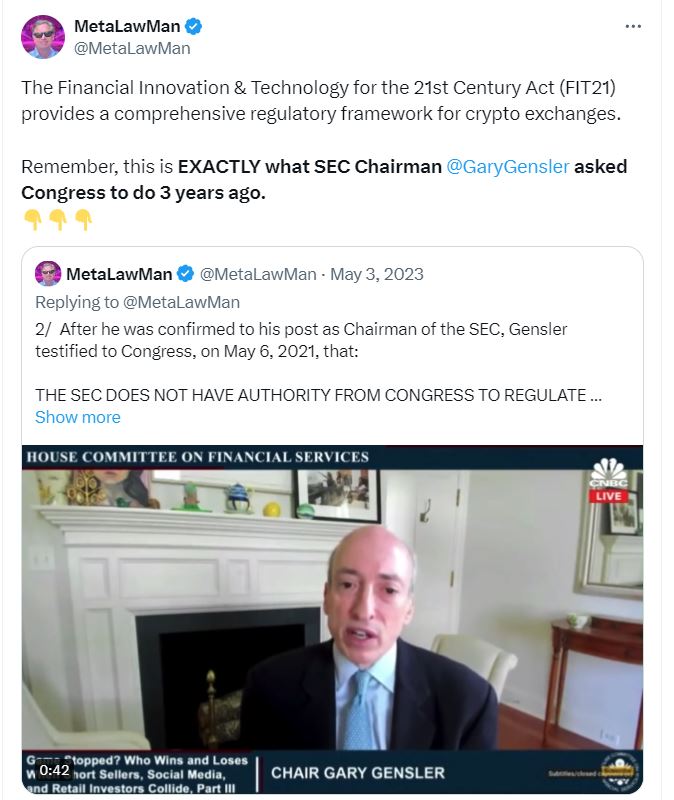This month marks a potential turning point for the cryptocurrency industry as the House of Representatives gears up to vote on the Financial Innovation and Technology for the 21st Century Act (FIT21).
The FIT21 bill, formally designated as HR 4763, seeks to streamline cryptocurrency regulation across the United States. It aims to establish a clear regulatory framework for digital assets, addressing their unique characteristics and ensuring consumer protections.
Regulatory Roles and Classifications
A primary objective of the bill is to delineate the regulatory roles of the Commodity Futures Trading Commission (CFTC) and the Securities and Exchange Commission (SEC). This distinction is critical because it determines whether digital assets are classified as securities or commodities, thereby affecting their regulation.
Under the proposed legislation, the CFTC would regulate digital assets if the associated blockchain or digital ledger is both functional and decentralized. Conversely, the SEC would oversee assets as securities if the blockchain is functional but not decentralized. Decentralization, as defined by the bill, means that no single entity controls more than 20% of the digital asset or its voting power.
Support and Criticism Over The FIT21
The bill has garnered bipartisan support but also faced criticism, particularly from the crypto community. Some stakeholders are concerned about the bill’s strict decentralization requirements, fearing it grants the SEC excessive power to withdraw support from tokens or projects that shift towards centralization. Additionally, there are worries that the bill does not clearly delineate the boundaries between the SEC and the CFTC’s authorities, potentially leading to regulatory confusion.
Despite these concerns, proponents of FIT21 argue that the bill will provide the regulatory clarity the crypto industry needs to thrive in the U.S. They believe that clear rules will help crypto businesses gain public trust, innovate with confidence, and ensure accountability for bad actors. As the House of Representatives prepares to vote, the entire crypto industry is watching closely, hopeful that FIT21 will usher in a new era of clear and effective regulation.
Comparison with the EU’s Approach
This development is particularly significant considering that the European Union (EU) has made substantial strides in creating a comprehensive regulatory framework for cryptocurrencies, leaving the United States trailing with a fragmented and uncertain regulatory landscape.
The EU has taken a proactive approach to cryptocurrency regulation with the introduction of the Markets in Crypto-Assets (MiCA) framework. MiCA aims to establish a clear and harmonized set of rules across all EU member states, providing legal certainty for both cryptocurrency businesses and investors.
This regulation covers a wide range of crypto assets, including utility tokens, stablecoins, and other digital assets, ensuring they are subject to robust consumer protection, transparency, and anti-money laundering (AML) requirements. MiCA’s comprehensive nature and its focus on consumer protection and market integrity make it a pioneering piece of legislation in the crypto space.
In contrast, the regulatory approach in the United States has been piecemeal and inconsistent. Multiple regulatory bodies, including the Securities and Exchange Commission (SEC), the Commodity Futures Trading Commission (CFTC), and the Financial Crimes Enforcement Network (FinCEN), have jurisdiction over different aspects of the cryptocurrency market.
This fragmented regulatory environment has created uncertainty for crypto businesses and investors, as they must navigate a complex web of regulations that can vary significantly from one state to another. Additionally, the lack of clear guidance on the classification of certain crypto assets has led to legal disputes and enforcement actions that further complicate the regulatory landscape.
The U.S. Regulatory Landscape
One of the key areas where the EU has outpaced the U.S. is in the regulation of stablecoins. MiCA includes specific provisions for stablecoins, recognizing their potential to facilitate payments and enhance financial inclusion while also addressing the risks they pose to financial stability and monetary policy. In the U.S., however, stablecoin regulation remains largely undeveloped, with various proposals and reports yet to culminate in a cohesive regulatory framework.
Moreover, the EU’s regulatory approach reflects a more collaborative and forward-looking stance. European regulators have engaged with industry stakeholders to develop regulations that foster innovation while ensuring robust oversight. This approach contrasts with the U.S., where regulatory actions have often been reactive and enforcement-focused, potentially stifling innovation and driving crypto businesses to more favorable jurisdictions.
As the House of Representatives prepares to vote on FIT21, the outcome could significantly influence the future trajectory of the cryptocurrency industry in the United States, potentially aligning it more closely with the comprehensive and proactive regulatory framework established by the EU.
Credit: Source link
